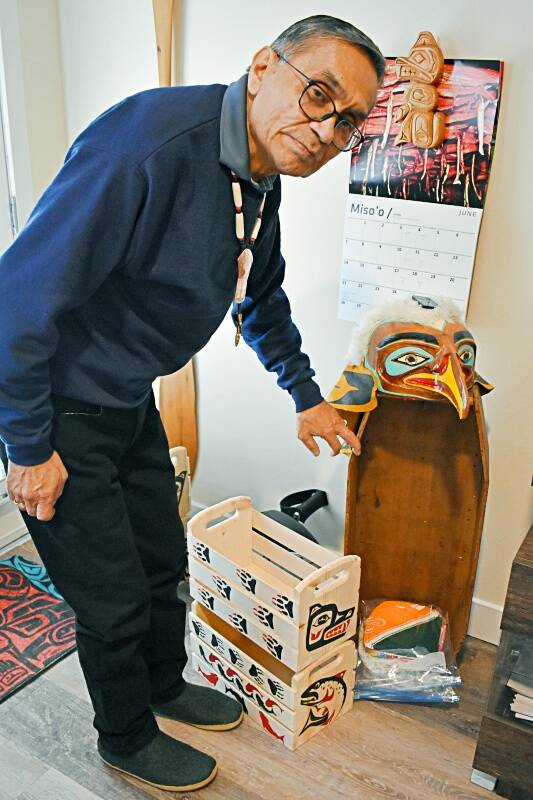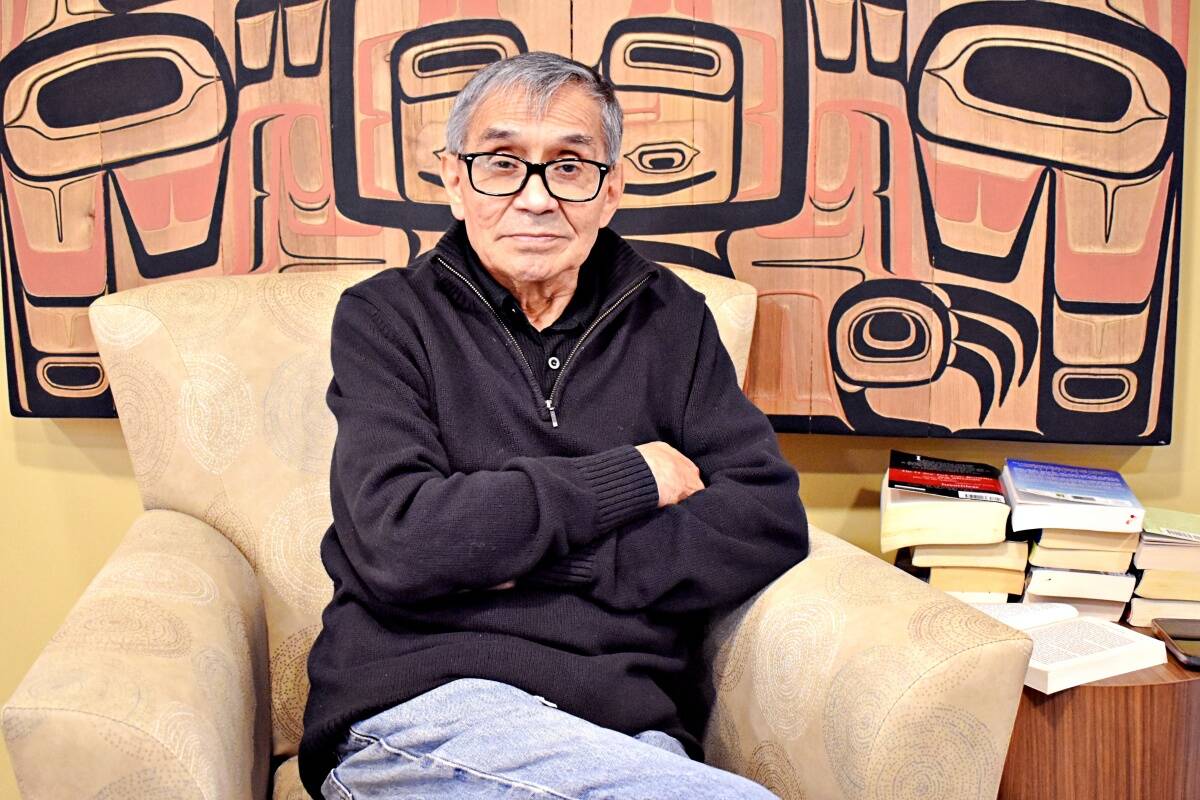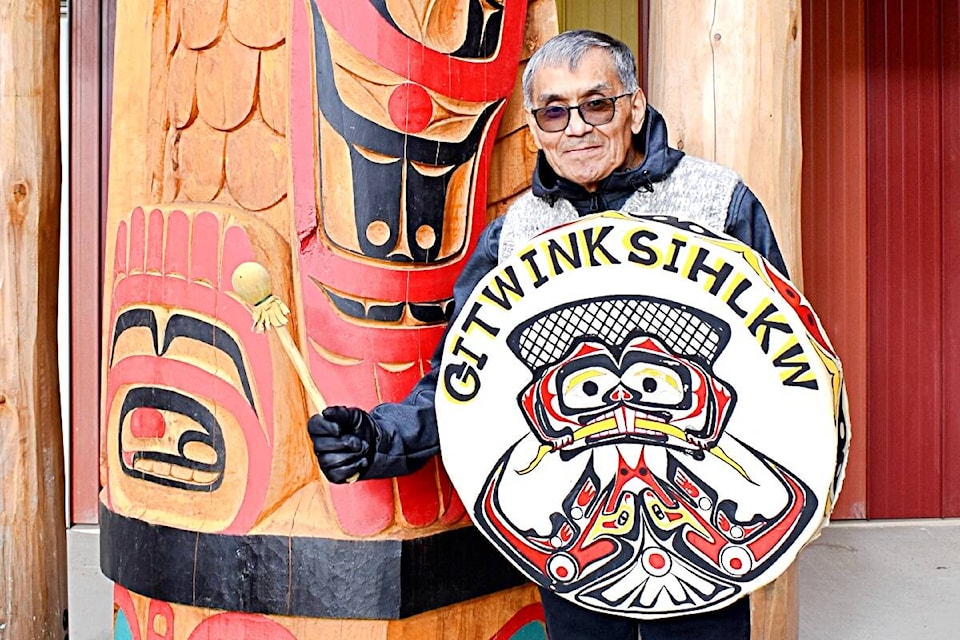“Truth and reconciliation is a hope.”
“In my view, it is a hope that all people can come together and treat each other with more respect, and realize we are all equal no matter what,” said Ron Nyce (Simoogt Gileen), Nisga’a elder and chief.
Respect is not what Ron Nyce woke up to in his early childhood.
Born in December 1948, in the Nass Valley village of Gitwinksihlkw, just 150 kilometres north of Kitimat, Ron was raised in the traditional Nisga’a way — hunting, fishing, and learning respect for all things. When he was old enough he started at the Canyon City Salvation Army-run Indian Day School to learn other things.
“My dad didn’t like the school … He said, ‘I want to move to Prince Rupert to get our children into a real school.’ He felt a day school wasn’t a real school because it was more or less teaching Christianity and the Bible. It wasn’t teaching us how to read or write,” Ron said.
In 1954, when Ron was five years old, his father managed to purchase a house in Prince Rupert where the family relocated.
Ron could not speak any English; he had never seen a “white person” before. He said as a little boy it was really strange at first.
“I didn’t know they existed. We thought we were the only ones in the world. Where else would we have seen anyone else? But when we moved here, we didn’t realize there are different coloured people other than just us.
“And I have to say we were survivors of abuse. There was a lot of prejudice. There was the odd family who was not that way.”
As he pictures some acts of kindness in his mind, he remembers a neighbour across the street who was friendly to his mother even though she spoke no English. But with the flashes of kindness behind his eyes, he also sees the images of injustice.
He recalls being teased over his homemade bread and fish sandwiches. He remembers being spat on in the washroom by boys who ate store-cut bread and roast beef sandwiches. He said they are still in Prince Rupert and he sees them around occasionally. He has never received an apology.
“Wouldn’t it be nice if they did?” he said.“Some kids even had their dogs chase after us. I felt somewhat like a little animal,” he said.
Ron, his elder brother Harry and younger sister May started to attend Conrad Elementary school where the teachers were good, Ron said, and the principal, Mr. Bateman, was “really exceptionally wonderful.”
However, his new life changed drastically when his mother was diagnosed with tuberculosis (TB).
“I guess the government or the powers that be thought my dad couldn’t look after us.”
At the age of seven, when his mother and another sister were patients in Miller Bay TB Hospital, he was taken from his home along with Harry and May to be placed in a residential school in Edmonton, Alberta.
It happened very quickly and he can’t remember receiving any notice that it was going to happen.
“We were packing a little bit of our belongings — what little we had. We had no idea what was happening. Just a person came and got us. I don’t remember my dad making any resistance or anything. We got into a taxi cab, then we got taken down on the train.”
“We did a lot of crying because we didn’t want to leave our dad. We just felt absolutely lost.”
They didn’t get a chance to feel their mother’s loving arms around them before they left or to feel her kisses goodbye. His mom didn’t know her children were being taken.
Upon their arrival in Edmonton, they were segregated.
“My sister was on one side of the school and we were placed on the other. We were placed in dormitories with metal bunk beds like in the army.”
The dorms were divided into three floors of the building with the youngest boys on the lowest floor. Ron recalls there were six rows of ten bunk beds in his dormitory area, 120 boys. The brothers were not permitted to be in the same dorm.
“There must have been at least 300 to 400 other boys of different ages at the school. We weren’t even introduced to anybody. We just got thrown into the whole works as well as just befriend whoever.”
It took him a while to make friends because the boys were all timid and reserved at first. Ron said he did become friends with an Inuit boy.
“He was what they called an Eskimo. He was my best buddy. He was from Nunavut. Boys were coming in from all over, we weren’t the only ones. He was my best friend.”
Any piece of identity was stripped from the children and their clothes were replaced with denim jeans and shirts, Ron said.
At meal times they would all line up just like in a military regimented routine.
“We didn’t get to choose our breakfast. We got served whatever was there. I mostly remember mush, like porridge … Some of our people that were there would comment out loud, what kind of slop are we going to have today.”
There was never enough to eat. Sometimes he would see older boys with an extra slice of bread. He doesn’t know how they got it, maybe they stole it, he said.
Because the children were punished for speaking their own language, they gravitated toward the older boys and relied on them to learn the ways of the residential school system to avoid being beaten.
“I don’t think we’re really taught [school lessons]. It was the same as that day school my dad didn’t like. It was just something to be there to turn you into a different person — not a First Nations person, far from it. They called it taking the First Nations out of you.
“There were a few times … like others I was hit. Maybe it was my own fault because I tried using my own language, but if I bided by how I was told to act and not to speak our own language, I was treated not too bad.”
Ron has carried the atrocities and anguish of what occurred during those dark days inside him since his return from residential school in 1960. The now-74-year-old never voiced a word about his experiences until five years ago.
“I’m not embarrassed talking about it. It’s actually sad because I’m wondering how many of us got what I got …” he said, adding kids never talked about what was going on and stayed silent even between themselves.
Ron described the dormitory master walking through the bunks at night with a stick.
“At times, he would take one of us out and be gone for a couple of hours. I used to wonder what he’d do with those kids — until one night he chose me.”
The man who abused him also made threats against his life if he ever spoke of it, he said.
“He said he could beat me to a pulp and get away with it.”
He described the sexual abuse happening so often, and to so many, he thought it was normal. Sometimes they would receive treats as an incentive or reward.
More than 60 years later Ron doesn’t like chocolate bars and still sleeps facing the door every night.
Ron sat down with Black Press Media to reflect on his experiences and share what happened to him so it never happens to another child. So the country can face the truth and reconcile the wrongs that have been branded into the children of Canada’s first people.
Many of those children have grown into adults who today are business professionals, politicians and community leaders. But there are others whose internal wounds have become infected to the point of visibility, even within subsequent generations, resulting in homelessness, alcoholism, substance use, self-harm, and harming others.
From 1870 to 1997, across Canada, there were 699 day schools, and 139 residential schools. More than 150,000 Indigenous, Metis and Inuit children between the ages of 4 to 16 were victims of these institutions.
“I have overcome now. I know that is never going to happen to me again,” Ron said.
He was 11 years old and had been at St. Alberts for five years when on a summer day in 1960 he, Harry and May were hustled onto a train with other Nisga’a, Gitxsan, and Ts’msyen youth from the school.
After a long journey, the train stopped at Sunnyside Cannery, which used to be located between the Cassiar and North Pacific Canneries in Port Edward. His dad was a fish packer and his mom was a net mender. He remembers the train slowing, people waving from the large crowd lining the tracks and children being hugged by their parents as they alighted from the train.
“There were lots of people waiting for their children to get off the train. It was just a big crying welcome back for families to see each other for the first time in so many years,” he described.
“We didn’t know how to act. We’re sort of shy. I don’t even remember if we got a hug or anything. I don’t remember any of that. It was just crazy.”
After spending the summer at the cannery while their parents worked, they moved back to their family home in Prince Rupert for the start of the school year where Ron and May again attended Conrad Elementary. They were back only briefly when Harry was taken for a second time and sent to Port Alberni Residential School. A few years later, the family suffered again when Ron’s younger sisters were taken and placed in foster care.
Initially, when the three siblings returned from St. Albert, Ron’s mom asked a lot of questions, he said. She asked if they received the letters, money and cards for birthdays, or the Christmas presents she sent, of which the children never received. But they never provided answers to some of her many questions.
“It was probably both too painful and just to get on with life,” he said.
“I think a lot of it was embarrassment. Embarrassed to say what happened to you after you realized that something was happening to you. You didn’t realize that when you were there.”
Ron’s wife didn’t know either, even after being for married 35 years, until he told his story a few years ago.
He coped with keeping his trauma locked in his heart for more than six decades with the help of the spiritual upbringing he received from his parents and grandparents. His grandfather taught him that God or the Creator, as well as his ancestors, would listen if he prayed.
“That type of upbringing really helped me and still today has helped me overcome a lot of difficult situations.”
He keeps his flame of strength ignited, he said, by helping others.
“It doesn’t necessarily have to be those abused in residential schools, it could be sexual abuse of any kind. If it’s happening to you today, then listen to my story. Be open with it because it happened to you and you don’t want it to happen to others.”


